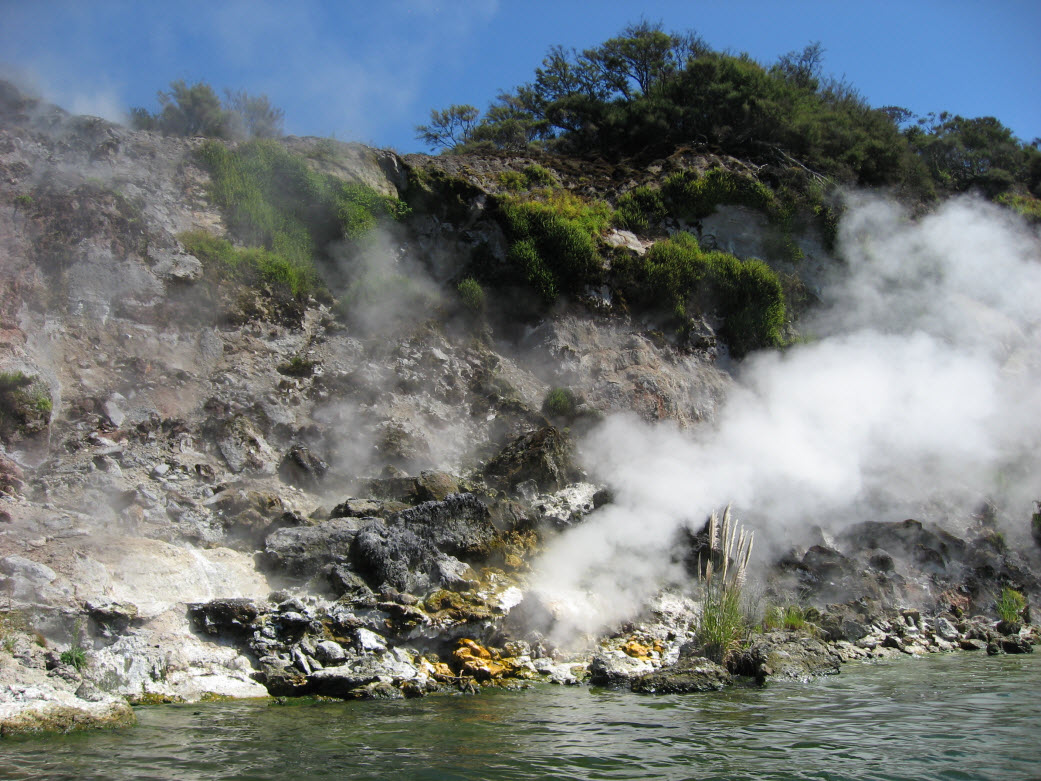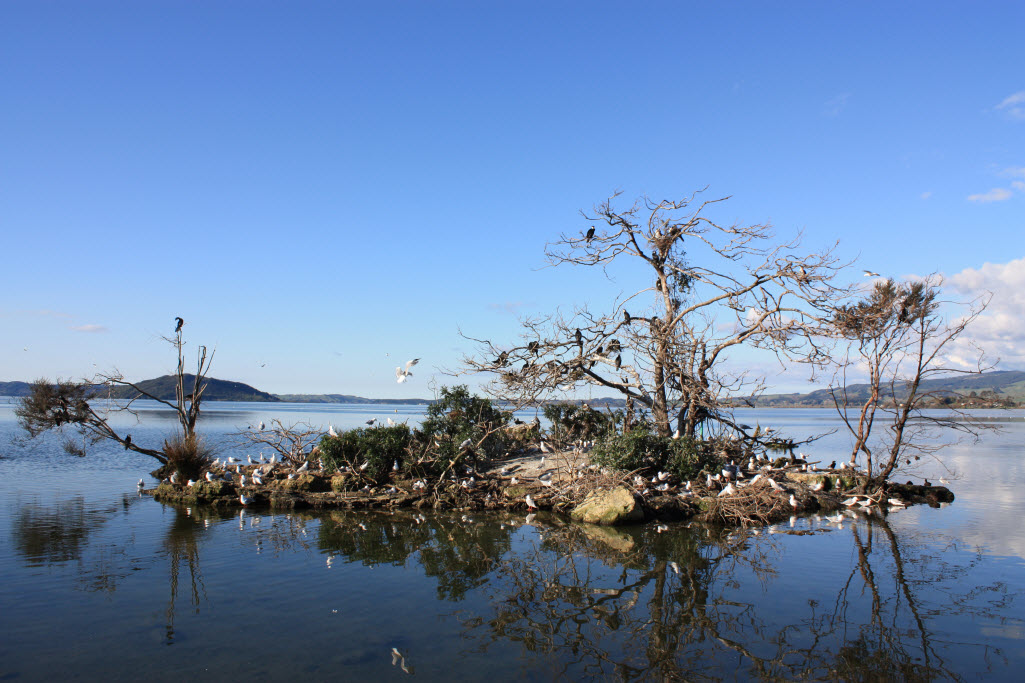Research Summary: Mercury Biomagnification In Three Geothermally-Influenced Lakes Differing In Chemistry And Algal Biomass
1Mercury (Hg) biomagnifies in aquatic organisms, meaning that concentrations in tissues of biota increase as trophic position in food chains increases. Highest Hg concentrations are expected in top predators such as trout. The effects of environmental factors including biomass dilution in concert on biomagnification of Hg remain insufficiently known and warrant investigation. Various environmental variables have been shown to correlate positively (water temperature, organic matter in the sediment) or negatively (conductivity, pH, alkalinity, and concentrations of dissolved oxygen, Ca and SO4) with Hg in fish, possibly in part resulting from effects on biomagnification. On the other hand, the effect of plankton biomass on Hg biomagnification and concentrations in fish appears more controversial. Concentrations of Hg in phytoplankton, zooplankton and fish have been shown to be lower in eutrophic lakes than in oligotrophic lakes with similar contaminant loading, as a result of dilution by higher plankton biomass in the more eutrophic lakes. This lead to the conclusion that biomagnification of Hg is higher in oligotrophic lakes. However, others have shown higher Hg concentrations in fish in more eutrophic lakes compared with oligotrophic lakes. Therefore, whether and how plankton biomass affects Hg biomagnification is not clear. Consequently, the objectives of this study are: to compare Hg concentrations and Hg biomagnification in the food webs of three lakes, Lake Rotorua, Lake Rotomahana and Lake Tarawera in the Bay of Plenty Region in New Zealand, and examine links with environmental factors. These lakes are within the Taupo Volcanic Zone and have elevated Hg concentrations associated with geothermal inputs. The lakes range from eutrophic, mesotrophic to oligotrophic as defined by their respective concentrations of algal biomass. There are also marked differences between the lakes in terms of their physico-chemistry.

A steaming rock wall on Lake Rotomahana. (Credit: Piet Verburg)
Methods
Samples of organisms were collected for analysis of Hg and isotopic ratios of nitrogen. Three species of fish, rainbow trout (Oncorhynchus mykiss), smelt (Retropinna retropinna), and common bullies (Gobiomorphus cotidianus), were collected. In addition, samples of several snail species, mussels, crayfish and other invertebrates, phytoplankton, and zooplankton were collected. Data on water temperature, organic matter in the sediment, conductivity, pH, alkalinity, and concentrations of dissolved oxygen, Ca, SO4, and chlorophyll a (a proxy for algal biomass), averaged over several years, were used to examine relationships with environmental factors. We used stable nitrogen isotopic ratios (d15N) to examine the relationship between trophic position and Hg concentration in components of the food web and to infer biomagnification of Hg in the food web. d15N is a useful indicator of trophic position in food webs because it increases along the food chain from primary producers to the top predator. Hg biomagnification is expressed as the trophic magnification factor (TMF) which is the antilog of the slope of the linear regression of log Hg against d15N, measured in the various organisms in the food webs of each lake. Food chain length was calculated as the difference in δ15N between phytoplankton and trout. Log transformed ratios were calculated of Hg concentrations in trout and water and of Hg concentrations in trout and algae.

Mount Tarawera overlooks Lake Tarawera. (Credit: Piet Verburg)
Results
The average concentration of Hg in trout exceeded the maximum recommended level for consumption by up to 440%. While there were differences between lakes in food chain length, Hg concentration in trout did not increase with food chain length, suggesting other factors were more important. Hg in phytoplankton decreased with increasing eutrophication, suggesting the effect of biomass dilution. In contrast, Hg biomagnification and Hg concentrations in trout were controlled by environmental physico-chemistry and were highest in the eutrophic lake and least in the oligotrophic lake. In the eutrophic lake, all eight measured physico-chemical variables had values more conducive to higher Hg in fish than in the other, less eutrophic lakes. In the more eutrophic lakes, frequent anoxia occurred in bottom water, resulting in favorable conditions for Hg transfer into and up the food chain.

Birds nesting on Lake Rotorua. (Credit: Piet Verburg)
Conclusions
Differences between the lakes in biomagnification and Hg concentration in trout correlated as expected from previous studies, with eight physico-chemical variables including anoxia in bottom water, resulting in enhanced biomagnification of Hg in the eutrophic lake. Evidence was provided both by TMF’s, ratios of Hg concentrations in trout and water, and by ratios of Hg concentrations between biota, that biomagnification was greatest in the most eutrophic lake and least in the oligotrophic lake.
Our results regarding Hg biomagnification and its relationship with plankton biomass conflict with what was expected from earlier work which suggested biomass dilution by high plankton biomass in eutrophic lakes to result in lower Hg biomagnification. However, for biomagnification to be reduced in eutrophic lakes under this biomass dilution scenario, Hg concentrations in higher-trophic-position organisms would have to decrease proportionally more than in lower trophic position organisms. This has not been previously pointed out nor has a mechanism been proposed to explain it. Our results suggest that predictions of Hg biomagnification in food webs and Hg concentrations in fish based on phytoplankton densities should be considered skeptically. Biomagnification of Hg in the food webs of our study lakes and Hg in trout was more strongly affected by differences in physico-chemistry between lakes than by differences in biomass dilution resulting from differences in the trophic state of the lakes. Our results may be explained in part by the fact that lower oxygen in bottom water and higher organic matter in the sediment, conducive to high Hg methylation rates, are typical features of highly productive lakes. Also, higher bottom temperatures are found in productive lakes because these are usually shallow, further enhancing methylation rates. In addition, higher temperatures may result in higher Hg in fish independently from methyl Hg (MeHg) concentrations in the sediment. It is therefore not surprising to find high Hg concentrations in fish in lakes with high algal biomass. With global climate change, this becomes increasingly more important because low oxygen conditions in bottom water in lakes are expected to become more common, which may result in enhanced production of MeHg and higher mercury concentrations in fish.
Full study published by Verburg P, Hickey CW and Phillips N. 2014. Mercury biomagnification in three geothermally-influenced lakes differing in chemistry and algal biomass. Sci. Total Environm. 493: 342–354. doi:10.1016/j.scitotenv.2014.05.097.
Selected References
- Borgå K, Kidd K, Muir D, Berglund O, Conder J, Gobas F, Kucklick J, Malm O, Powell D. Trophic magnification factors: considerations of ecology, ecosystems, and study design. Integr Environ Assess Manag 2012;8:64–84.
- Brooks RR, Lewis JR, Reeves RD. Mercury and other heavy metals in trout of the central North Island, New Zealand. N Z J Mar Freshw 1976;10:233-44.
- Cabana G., Rasmussen JB. Modelling food chain structure and contaminant bioaccumulation using stable nitrogen isotopes. Nature 1994;372:255-7.
- Chen CY, Folt C. High plankton densities reduce mercury biomagnification. Environ Sci Technol 2005;39:115-21.
- Chen CY, Stemberger RS, Kamman NC, Mayes BM, Folt CL. Patterns of Hg bioaccumulation and transfer in aquatic food webs across multi-lake studies in the northeast US. Ecotoxicology 2005;14:135-47.
- Dijkstra JA, Buckman KL, Ward D, Evans DW, Dionne M, Chen CY. Experimental and natural warming elevates mercury concentrations in estuarine fish. PLoS ONE 2013;8:e58401. doi:10.1371/journal.pone.0058401
- Fry B. Stable isotope diagrams of freshwater food webs. Ecology 1991;72:2293–2297.
- Kidd KA, Hesslein RH, Fudge RJP, Hallard KA. The influence of trophic level as measured by d15N on mercury concentrations in freshwater organisms. Water Air Soil Poll 1995;80:1011-15.
- Kim JP. Methylmercury in rainbow trout (Oncorhynchus mykiss) from Lakes Okareka, Okaro, Rotomahana, Rotorua and Tarawera, North Island, New Zealand. Sci Total Environ 1995;164:209-19.
- Kim JP, Burggraaf S. Mercury bioaccumulation in rainbow trout (Oncorhynchus mykiss) and the trout food web in Lakes Okareka, Okaro, Tarawera, Rotomahana and Rotorua, New Zealand. Water Air Soil Poll 1999;115:535-46.
- Krabbenhoft DP, Sunderland EM. Global change and mercury. Science 2013;341:1457-58.
- Pickardt PC, Folt CL, Chen CY, Klaue B, Blum JD. Algal blooms reduce the uptake of toxic methylmercury in freshwater food webs. Proc Natl Acad Sci USA 2002;99:4419–23.
- Timperley MH, Vigor-Brown RJ. Water chemistry of lakes in the Taupo Volcanic zone, New Zealand. N Z J Mar Freshw Res 1986;20:173-83.
- Verburg P. Lack of evidence for lower mercury biomagnification by biomass dilution in more productive lakes: comment on “Mercury biomagnification through food webs is affected by physical and chemical characteristics of lakes”. Environmental Science and Technology 2014; in press. doi:10.1021/es405415c.














[…] have met long-term water quality goals, according to Radio New Zealand News. They include Lakes Rotorua, Rotoiti, Okaro, Rerewhakaaitu and […]